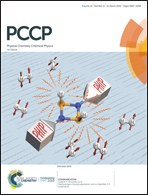Role of suppressed oxygen vacancies in the BiFeO3 nanofiller to improve the polar phase and multifunctional performance of poly(vinylidene fluoride)†
Abstract
In the present work, we report the enhanced dielectric, ferroelectric, energy storage and energy harvesting performance of a citrate-gel synthesized Bi1−xBaxFeO3 (x = 0, 0.05, 0.10) incorporated poly(vinylidene fluoride) (PVDF) matrix. Doping with aliovalent ions has been shown to improve the multiferroic properties of BiFeO3. Though Ba2+ doping has been expected to introduce more oxygen vacancies, here we found a decrease in oxygen vacancies with increasing Ba2+ up to 10% doping. This suppression of oxygen vacancies through Ba2+ doping in BiFeO3 helped in the formation of the polar PVDF phase in the composite through interfacial interaction. The polar phase fraction (F(EA)) increases to 82.4% for the 7 wt% Bi0.9Ba0.1FeO3 incorporated PVDF film from 38.2% for the neat PVDF. This film also showed the highest energy storage density of 5.4 mJ cm−3 at a 110 kV cm−1 applied field and the highest energy harvesting performance of ∼20 V open circuit output voltage after application of repeated human finger tapping and releasing motion, due to its enhanced piezoelectric property. Here, we also demonstrate the enhanced energy harvesting capability of the said PVDF–Bi0.9Ba0.1FeO3 composite by charging a 10 μF commercial capacitor up to ∼5 V in 270 s, which can comfortably light up about 50 LEDs instantaneously.

- This article is part of the themed collection: 2019 PCCP HOT Articles


 Please wait while we load your content...
Please wait while we load your content...